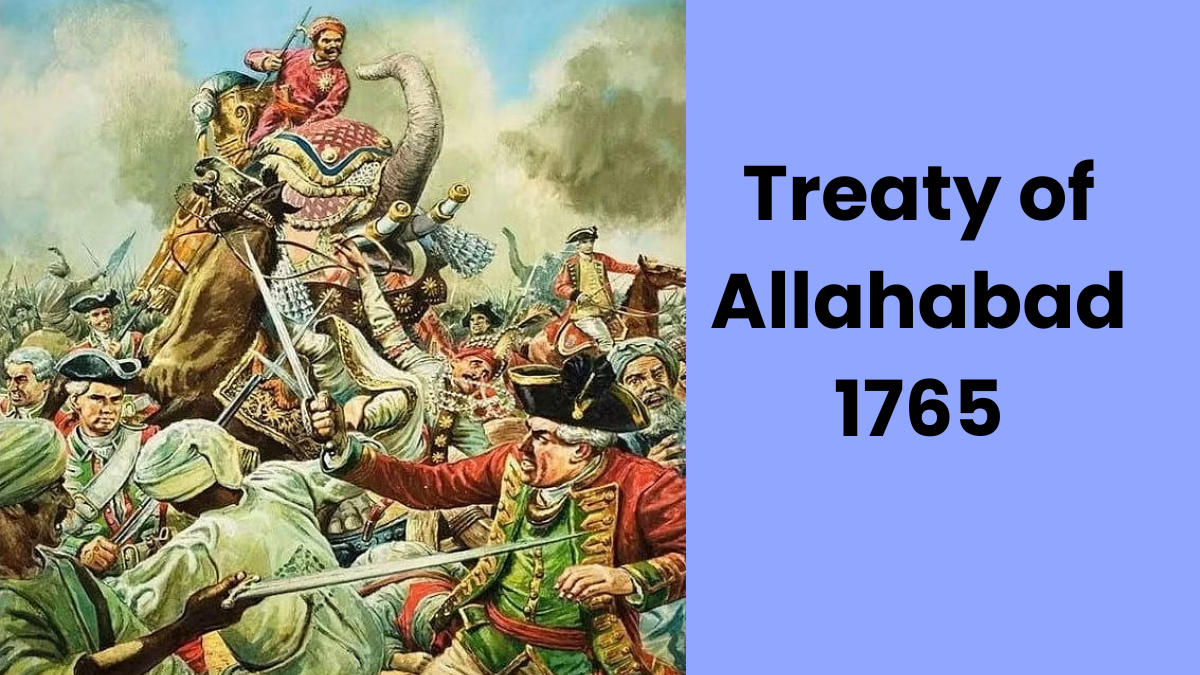Table of Contents
The Treaty has signed in 1765, marked a significant turning point in Indian history, This treaty is crucial for the UPSC exam as it underscores the beginning of British dominance in India, Treaty of Allahabad is the most important topic in Priliminary and Mains Examination of UPSC and State Pcs examination.
The Treaty of Allahabad topic comes under the UPSC Mains Examination syllabus in GS Paper-1.
- GS Paper 1: Indian History- Modern Indian history from about the middle of the eighteenth century until the present- significant events, personalities, issues.
Treaty of Allahabad 1765- Background
- Treaty of Allahabad 1765 was an outcome of the Battle of Buxar 1764 fought between the combined forces of the Mughal emperor, Nawab of Awadh and Bengal and the British East India Company (EIC).
- A combined army of 40,000 belonging to Mughals, Awadh, and Mir Qasim was brutally defeated by the British Army comprising of 10,000 men.
- Indian side lost the battle of Buxar on October 22, 1764.
- Mir Qasim absconded from the battle and the other two surrendered to the English army.
- The British EIC forced a humiliating Treaty of Allahabad on Mughal Emperor and Nawab of Oudh in 1765.
Treaty of Allahabad 1765- Key Points
- Diwani Rights: The Mughal Emperor Shah Alam II granted the British East India Company the right to collect taxes (Diwani rights) in the regions of Bengal, Bihar, and Orissa.
- Protection and Support: The British promised to protect Shah Alam II and restore him to the throne, solidifying their influence in the region.
- Territorial Gains: In return for their support, the British received certain territories as part of their expanded control over India.
- Military Support: The British agreed to provide military assistance to the Mughal Emperor in case of any external threats.
Treaty of Allahabad 1765- Treaty between Nawab of Awadh and EIC
- Surrender of Allahabad: Robert Clive made Shuja-Ud-Daulah surrender Allahabad and Kara to Shah Alam II (Mughal Emperor).
- War Indemnity Clause: Clive blamed Nawab and his allies for the war and imposed a war indemnity of 50 lakh that Nawab had to pay to the British East India Company (EIC).
- Snatching Nawab’s estate: Robert Clive forced Nawab to hand over complete control of his property to Balwant Singh (Zamindar of Banaras).
Battle of Plassey 1757: Background
Treaty of Allahabad 1765- Treaty between Mughal Emperor and EIC
- The Company made Shah Alam II abandon Delhi and forced him to live in Allahabad (surrendered by Shuja-Ud-Daulah under the Treaty of Allahabad) under the protection of the East India Company.
- Granted Diwani Rights: The Company forced the emperor to issue a ‘Farman’ granting the East India Company the Diwani of Bengal, Bihar, and Orissa instead of an annual payment of Rs 26 lakh.
- Nizamat Functions: The company charged the Mughal Emperor an amount of Rs 53 lakh in return for its nizamat functions (military defense, police, and administration of justice) of the Bengal, Bihar, and Orissa provinces.
Historical Significance of the Treaty
- The historic Treaty of Allahabad was signed in 1765 between Mughal Emperor Shah Alam II and the East India Company (EIC). This pact marked the beginning of British political domination in India.
- As part of the treaty, the Mughal Emperor granted the East India Company the Diwani rights, which gave them the authority to collect taxes in Bengal, Bihar, and Orissa. This arrangement not only paved the way for British colonial rule in India but also ensured the financial success of the Company, while significantly weakening the power of the Mughal Empire.
- Thus, the Treaty of Allahabad is seen as a turning point in Indian history, symbolizing the transfer of authority from traditional Indian rulers to European colonial powers.
| Related Articles | |
| Advent of Aryans | |
| Economic and Social life of Aryans | |
| List of Archaeological Findings & Evidences Prehistoric & Indus | |
| Later Vedic Age (1000-600 B.C.) | |



 TSPSC Group 1 Question Paper 2024, Downl...
TSPSC Group 1 Question Paper 2024, Downl...
 TSPSC Group 1 Answer key 2024 Out, Downl...
TSPSC Group 1 Answer key 2024 Out, Downl...
 UPSC Prelims 2024 Question Paper, Downlo...
UPSC Prelims 2024 Question Paper, Downlo...




